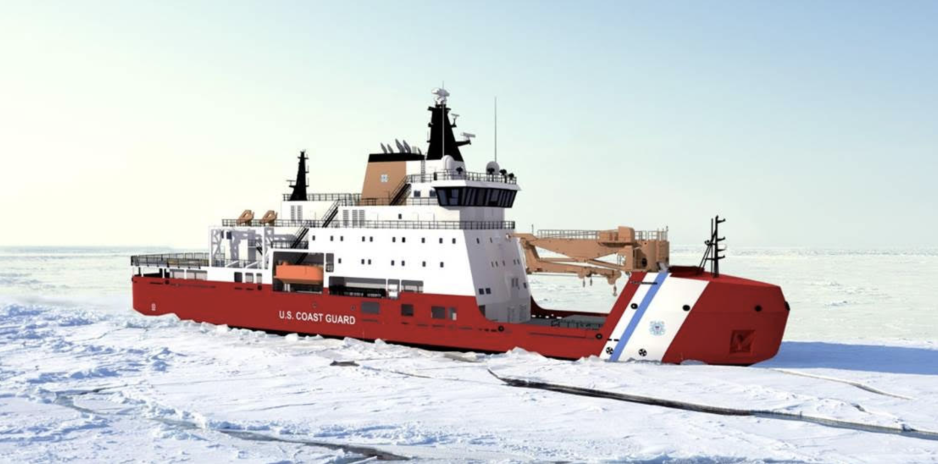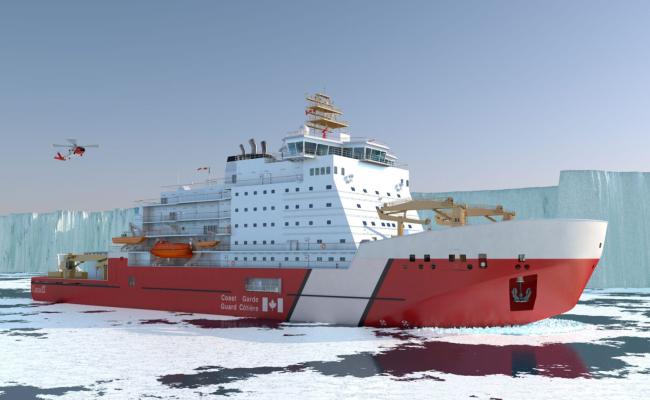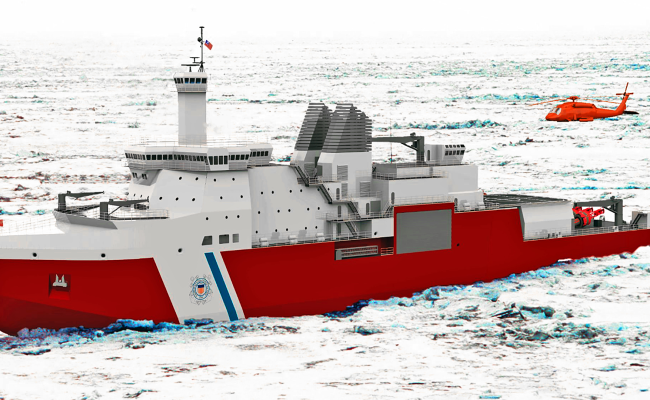Finnish and Canadian Firms Partner with American Shipyard to Pitch Icebreaker Design for U.S. Coast Guard

Mockup of the production-ready MPI design in U.S. Coast Guard icebreaker livery. (Source: Bollinger)
Within weeks of securing funding to build around a half dozen new icebreakers several U.S. shipyards as well as builders in Canada and Finland have thrown their hats in the ring to construct the new vessels for the U.S. Coast Guard. The capabilities of the different icebreaker designs and political considerations will likely determine which consortium is awarded a contract.
Efforts to build several new icebreakers for the U.S. Coast Guard continue to pick up steam. After years of funding shortfalls the USCG was allocated close to $9 billion for new icebreakers in early July as part of President Trump’s massive spending bill, with the majority of the total for large and medium polar vessels.
Several consortia of U.S.-based and international shipbuilders and icebreaker designers have since emerged vying for construction contracts.
Earlier this week the latest entrant came in the form of a trilateral partnership led by American shipyard Bollinger with Finnish allies Rauma shipyards and vessel designer Aker Arctic and Canadian Seaspan Shipyards. The alliance draws on the 2023 ICE pact signed by the Biden administration with counterparts in Canada and Finland to boost icebreaker construction.
With ample funding to build around a half dozen new icebreakers the U.S. Coast Guard is looking for partners who can design and construct several medium-size Arctic Security Cutter icebreakers.
Designs meet requirements
In a recent Request for Information (RFI) aimed at global shipbuilders the USCG laid out the vessel capability parameters: the ability to break through 3ft of ice with an endurance of 60 days and a range of 6,500 nautical miles.
The Coast Guard aims to place the ASC into service within 36 months from contract awarding
The vessels will complement the larger Polar Security Cutter, of which one is currently under construction at Bollinger’s Mississippi yard, with likely two more to follow in the 2030s.
The Coast Guard aims to place the ASC into service within 36 months from contract awarding; a threshold encouraging U.S. shipyards to partner with Finnish firms, which have routinely met such deadlines.
Apart from the Bollinger-lead consortium, Canadian builder Davie is looking to compete for construction of the ASC with a rival design. Davie Shipbuilding positioned itself to compete for icebreaker construction contracts through its acquisition of Finnish Helsinki Shipyard in 2023. It also announced a move to buy assets along the Texas Gulf Coast this past June, likely in an effort to expand its U.S. footprint.
Political considerations
Traditionally American defense spending is only allocated to U.S.-based firms, but urgency in constructing new icebreakers will likely facilitate a presidential waiver to bring international help on board.
Nonetheless, political considerations will almost certainly play a role in contract awarding. The initial batch of ASC icebreakers will likely be partially or fully constructed abroad before construction could shift to U.S.-yards following knowledge and technology exchange for subsequent vessels.
Both the Bollinger-led and Davie-spearheaded proposals aim to show the capability for both a rapid ramp-up of production to meet the 36 months deadline, while also highlighting U.S.-based assets that will be part of any long-term construction contracts.
Bollinger would likely rely on its Canadian partner Seaspan’s design for the Multi-Purpose Icebreaker (MPI), while Davie could draw on the proven Multi-Purpose Polar Support Ship (MPPS). Both designs would meet the Coast Guard’s capability parameters, though based on publicly available data sheets the MPPS is the more capable design with more engine power, longer endurance, and further range.
But the likely lower acquisition and operational costs of the MPI may make it an attractive offering for the U.S. Coast Guard, which has historically faced tight funding and a maintenance backlog of close to $7 billion.



